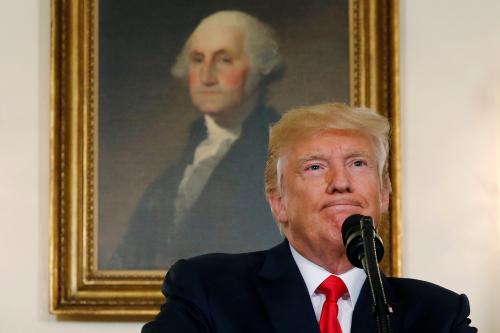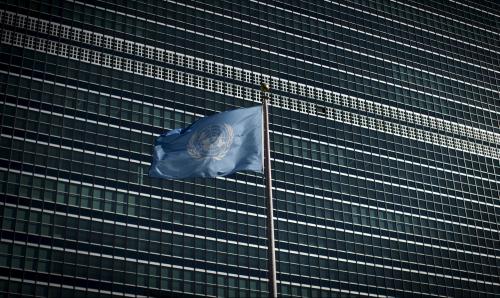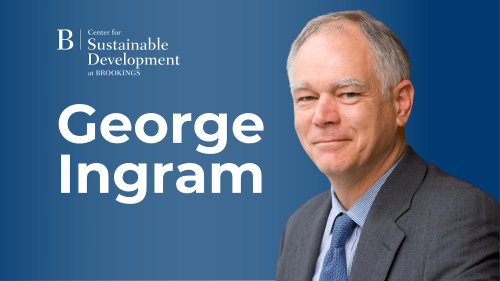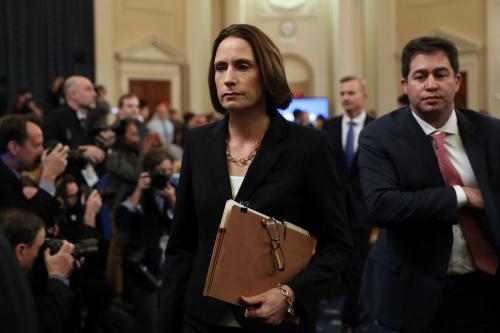Observing recent developments in the United States, one might assume that countering/preventing violent extremism (CVE or PVE) is a quickly disappearing policy fad of the Obama administration. These efforts encompass a range of law enforcement and non-law enforcement means to prevent individuals from being radicalized to violence, with a focus on addressing the grievances that make individuals vulnerable to recruitment to terrorist organizations and intervening before individuals become violent.
The Trump administration has zeroed out the short-lived Department of Homeland Security CVE grants program, effectively disbanded the inter-agency CVE task force, and showed nothing but disdain for the CVE policy of the Obama-era that sought to empower communities and catalyze locally-led interventions to build resilience against violent extremism across the ideological spectrum. Most recently, in her Congressional testimony last month on “Threats to the Homeland,” Acting Secretary for the Department of Homeland Security Elaine Duke eschewed the “countering violent extremism” framing of the Obama-era, pivoting instead to what the current White House views to be the more muscular and targeted label of “terrorism prevention.”
The State Department is also in the midst of trying to figure out what to do with its international CVE efforts, which mushroomed in the aftermath of President Obama’s CVE summits in 2015. Some are calling for a focus on preventing “homegrown violent extremism” (vice “CVE”) as one way to appeal to the Trump team.
However, much in the same way that global action to counter climate change marches on in spite of the Trump administration’s efforts to roll back Obama-era environmental rules and international commitments, so too does the global CVE movement, with its focus on prevention, as well as identifying and addressing the causes—not just the symptoms—of violent extremism. Even as the Trump administration changes its approach, global consensus around CVE as a critically important policy framework for addressing terrorism is alive and well and shows little signs of receding.
Friends in unlikely places
New or updated CVE or PVE policies, programs, and institutions continue to emerge in countries such as Australia, Canada, Italy, Jordan, Lebanon, Nigeria, Somalia, and the United Kingdom. The European Union, Japan, The Netherlands, and Norway continue to ratchet up their investments in support of CVE capacity-building efforts in developing countries.
Inspired by the still relevant 2016 PVE plan of action of the previous U.N. secretary-general, PVE “Groups of Friends”—involving some 40 countries from around the globe—have formed at the United Nations (in Geneva and more recently in New York). The United States remains a member of these groups, and CVE continues to be one of the frameworks for addressing terrorism employed by other key multilateral fora including the Global Counterterrorism Forum and the G-7.
Nowhere is evidence of CVE’s staying power more apparent than in international development agencies, institutions that had been historically reluctant to associate themselves with what was viewed by many as a Western-imposed security agenda. Now, with evidence that violent extremism poses a serious threat to development gains—and recognition by developing countries and development agencies that effective strategies vis-à-vis violent extremism need to include a development response—this reluctance has largely dissipated.
Recent progress in three pillars of the international development architecture—the Organization for Economic Cooperation and Development (OECD), the U.N. Development Programme (UNDP), and the World Bank—illustrates the fundamental shift that has taken place since President Obama’s CVE summitry, a shift that no single government can reverse.
OECD
In 2016, the OECD revised its official development assistance (ODA) guidelines to allow its 35 member states to report funding for PVE activities as part of their annual development targets—including education, rule of law, working with civil society to prevent radicalization, some security and justice systems capacity building, and research into positive alternatives to violent extremism. This will allow for more development assistance to be used to address the drivers of violent extremism.
There are calls for the OECD to assume an even greater role in influencing PVE programming and facilitate PVE coordination. This could include:
- Clarifying for donors the activities that fit within the PVE guidelines and helping to share both good and bad PVE practice;
- Assigning a reporting “code” to PVE in its databases to enable the OECD Secretariat to gather data on members’ spending on PVE;
- Convening discussion on the use of development aid for, and the collection of data on, PVE activities so that the sector is more closely monitored and understood from a development perspective.
UNDP
A few years ago, one would be hard-pressed to get a UNDP official, let alone the institution itself, to publicly identify itself with a counterterrorism or CVE discussion. Today, however, the largest U.N. development agency has an ambitious $100 million global PVE program (apparently none of it funded by Washington) and PVE program coordinator, with PVE projects in more than 45 countries funded by non-U.S. donors. This is something the new UNDP administrator, Achiem Steiner, highlighted in his first address to the organization’s Executive Board in September. UNDP recently released the findings of a two-year study on what motivates young people to join al-Shabaab and Boko Haram that involved interviews with nearly 500 recruits into these organizations.
UNDP’s PVE portfolio continues to grow, currently including some 63 projects across 47 countries, with ones focused on national capacity and coordination around PVE, training and engagement with religious leaders, youth-focused job creation, rehabilitating and reintegrating former violent extremists, and research on what works and what doesn’t to reduce violent extremism. In fact, it is implementing more PVE programs than any other U.N. entity. Last month, as a sign of UNDP’s deepening commitment in this area, and with funding support from the U.K.’s Foreign Office, UNDP entered into a partnership with the international CVE center of excellence—Hedayah—to support national and regional efforts to develop PVE action plans and strategies.
Some have questioned whether UNDP is simply repackaging its traditional development work as “PVE” in order to attract more funding from increasingly constrained donors. However, regardless of the motivation, what matters is that UNDP is engaging with national governments on the importance of developing holistic, multidisciplinary, and inclusive strategies for preventing violent extremism that elevate the need to identify and address real and perceived grievances—as opposed to just violent extremism’s symptoms—and is directing more of its expertise and resources to allow governments and civil society to contribute to the implement such strategies.
World Bank
However, the shift that could have the most significant long-term impact on how the international community seeks to tackle the threat of violent extremism is coming out of the World Bank, with violent extremism and PVE featuring in the recently-released joint U.N.-World Bank report on the role of development in preventing violent conflict.
Some of the Bank’s comprehensive research found that violent extremism (and violent conflict more broadly) is linked to grievances driven by strong perceptions of exclusion and unfairness in a population beyond the traditional individual targets of CVE or PVE interventions. The increased awareness that the drivers of violent conflict (and violent extremism more narrowly) are rooted in deeper societal issues linked to exclusion should lead the Bank (and other development agencies) to rethink its approach in certain countries.
Development programs have traditionally focused on the poorest segments of the population rather than on those with the strongest feelings of exclusion and unfairness. However, if development institutions are now going to prioritize preventing violent conflict (including violent extremism) from emerging, then they should channel more resources to those communities that are most prone to becoming radicalized to violence—and focus on building resilience and social cohesion within them. If acted upon, the findings in this World Bank-U.N. report could open up the spigot for additional development funds being directed to those segments of the population where feelings of marginalization and exclusion are the strongest rather than simply to those that are poorest.
How might this affect the relationship between the Bank, other development agencies, and countries facing violent extremism challenges? For example, in Kenya, the Bank found that the key structural drivers of violent extremism are the regional imbalance within the country, the lack of political participation at the local level in certain regions, and security force abuses against local populations. As such, the Bank should focus on decentralization, devolution, dialogue, and broader trust building efforts between law enforcement and local populations in certain parts of the country as among the keys to reducing extremism in Kenya. In concert with other influential international actors, the Bank should convince the Kenyan government to use some the loaned Bank funds to finance projects linked to these—and not simply the traditional development and economic reform.
Similarly, in Tunisia, the Bank should press the government use some of the Bank funds to finance projects to address the feelings of economic exclusion and marginalization in parts of the country that Bank research has identified as a key driver of violent extremism and in Nigeria, it should convince Abuja to use Bank loans to address the deficit of service delivery in the north that is generating the perception of marginalization and exclusion by some communities that is a key driver of violent extremism there.
Keep up the momentum
Of course, development resources and interventions alone will never be able to address the governance and human rights deficits, as well as other grievances, that can drive recruitment and radicalization to violent extremism. Development, diplomatic, and security actors need to work together, especially when it comes to reinforcing the links between progress in decentralization, equalization of service provision, dialogue between the police and communities, and resource allocation and reducing levels of violent extremism.
A few years ago, it would be difficult to imagine that the major international development institutions would not only be willing collaborators on these issues, but helping to drive the conversation. Although there are a number of factors behind this shift in attitude, the global CVE or PVE movement is certainly one and there appears little Washington can do to slow it down.
The Brookings Institution is committed to quality, independence, and impact.
We are supported by a diverse array of funders. In line with our values and policies, each Brookings publication represents the sole views of its author(s).











Commentary
How international development institutions are becoming hubs for addressing violent extremism
October 19, 2017